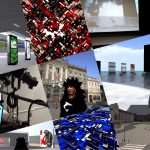“You Will Not Enter Twice Into the Same River: Today, Yesterday, Tomorrow” by Andreas Guskos, Irek Kuriata
Title:
Artist(s) and People Involved:
Exhibiting Artist(s):
-
Andreas Guskos
-
- The Eugeniusz Geppert Academy of Fine Arts
- Irek Kuriata
Symposium:
Venue(s):
Creation Year:
Medium:
Duration:
Artist Statement:
“Heraclitus says that everything changes and nothing remains and by illustrating the flow of the river he says that you cannot step twice into the same river.” by Socrates, after Plato, (Cratylus). After the conquer of Ionia by Persians in the middle of VI century B.C. many Greeks emigrated to western colonies, to the so called Great Greece (southern part of the Italian Peninsula and part of Sicily) with philosophers such as Xenophanes and Pythagoras amongst them. Xenophanes was the ancestor of Eleatic School of Philosophy and Pythagoras was the progenitor of Pythagorean Union. For Pythagoreans the most important substance of the universe was not matter, but the form it acquires by the inscribed information. Driven by such assumption they were discovering the harmony of the world (cosmos) associating it with music. The world cosmos (κόσμος) was applied to the Universe by Pythagoreans and it means harmony and order. One of the tools for learning philosophy was the monochord – a musical instrument by the help of which Pythagoreans discovered the harmonic tones. The most significant supporter of Pythagoreanism was Plato. He developed the concept of idea (ιδέα) as a matrix of all objects of the same kind existing in the material world. He considered the world of ideas as real and the material world only as a copy shaped by it (as it can be seen in the known parable about the cave). Aristotle saw the matter (ύλη) as host for the form (μορφή), which by his understanding was the information inscribed in the initially unshaped matter. For the Pythagoreans (numbers) and Plato (ideas) the substance (ουσία) was the information itself and for Aristotle it had dual nature, consisted of form (information) and matter (host). The word information comes from the Latin word informare, which means applying form, shaping.
The analogical word in Greek language, μόρφοση, stands for education. By considering the etymology of that notion, a wide definition of information would be: shaping anything, material or non-material, in a way that it could be later extracted and read by the receiver. The dualism of the substance (ουσία) consisted of unshaped matter (ύλη) and the information as a form (μορφή) was introduced by Aristotle. In physics (φυσική – physics, φύση – nature) there is a notion of entropy that can be described commonly as a measure of disorder. According to the second order of thermodynamics the entropy in a closed system always proceeds to the state of equilibrium that is a configuration with maximum entropy. There is a singularity in such system called life. Life decreases entropy and produces information in its spot. In nature there is a common process associated with life endless replication of information for the purpose of its propagation and preservation (DNA). According to the second law of thermodynamics life is a singularity and it is like a time-reverse process. The word history comes from the Greek word ιστορία, which comes from the word ίστωρ witness, critic and that in turn comes from earlier form ίδτωρ, the combination of ιδ (from οίδα or είδα I know) and ίστμι (stream, record). Contemporary concepts of space and time are classifying time as another spatial dimension. In physics there are still unsolved outlooks about the nature of gravitation and magnetism and paradoxes of timespace, like e.g.: while time travel is theoretically possible, what would happen if we would go back and change some properties of the past? Would this change the course of history?
This artwork shows the idea of turbulent time-space that is constantly changing its form, where it is not possible to go back or forward to the place that existed or will be existing, because the target is never the same that it was in the past or it will be in the future. A section of a four-dimensional object generates a three-dimensional form. By moving the section’s location steadily in time, the resulting form will be subject of change depending on the properties of the four-dimensional object and will give the impression of motion. If the parent object is dynamical, re-section of a previously cut (“past”) location will give a different result. By analogy, a place of a future section will produce different image from the one generated by the assumed “present” section steadily moved in time. The future and the past generated from present point of view is different than those generated by the “present” section moving in time. The projection “You will not enter twice into the same river” presents this idea by animation, on a model reduced by one spatial dimension.








